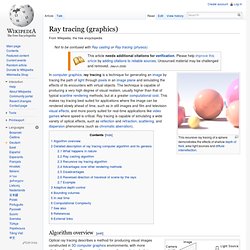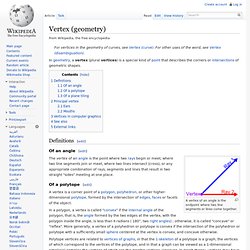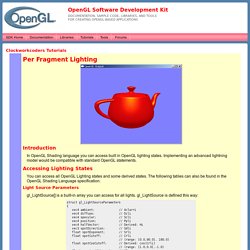

Three.js - JavaScript 3D library. Ray tracing (graphics) The ray tracing algorithm builds an image by extending rays into a scene Optical ray tracing describes a method for producing visual images constructed in 3D computer graphics environments, with more photorealism than either ray casting or scanline rendering techniques.

It works by tracing a path from an imaginary eye through each pixel in a virtual screen, and calculating the color of the object visible through it. Scenes in ray tracing are described mathematically by a programmer or by a visual artist (typically using intermediary tools). Scenes may also incorporate data from images and models captured by means such as digital photography. Typically, each ray must be tested for intersection with some subset of all the objects in the scene. It may at first seem counterintuitive or "backwards" to send rays away from the camera, rather than into it (as actual light does in reality), but doing so is many orders of magnitude more efficient. Ray tracing can create realistic images. and radius. YafaRay. Cse.csusb.edu/tong/courses/cs520/notes/intro.php. List of common shading algorithms. Shading.
Shading refers to depicting depth perception in 3D models or illustrations by varying levels of darkness .

Drawing [ edit ] Example of shading. Shading is a process used in drawing for depicting levels of darkness on paper by applying media more densely or with a darker shade for darker areas, and less densely or with a lighter shade for lighter areas. There are various techniques of shading including cross hatching where perpendicular lines of varying closeness are drawn in a grid pattern to shade an area. The closer the lines are together, the darker the area appears. Light patterns, such as objects having light and shaded areas, help when creating the illusion of depth on paper. [ 1 ] [ 2 ] Computer graphics [ edit ] In computer graphics, shading refers to the process of altering the color of an object/surface/polygon in the 3D scene, based on its angle to lights and its distance from lights to create a photorealistic effect. Angle to light source [ edit ] Lighting [ edit ] Vertex (geometry)
A vertex of an angle is the endpoint where two line segments or lines come together.

In a polygon, a vertex is called "convex" if the internal angle of the polygon, that is, the angle formed by the two edges at the vertex, with the polygon inside the angle, is less than π radians ( 180°, two right angles) ; otherwise, it is called "concave" or "reflex". More generally, a vertex of a polyhedron or polytope is convex if the intersection of the polyhedron or polytope with a sufficiently small sphere centered at the vertex is convex, and concave otherwise. A vertex of a plane tiling or tessellation is a point where three or more tiles meet; generally, but not always, the tiles of a tessellation are polygons and the vertices of the tessellation are also vertices of its tiles. Vertex B is an ear, because the straight line between C and D is entirely inside the polygon. Computer Graphics Lecture Notes. Computer Graphics Principles :Opengl. Per Fragment Lighting. Introduction In OpenGL Shading language you can access built in OpenGL lighting states.

Implementing an advanced lightning model would be compatible with standard OpenGL statements. Accessing Lighting States You can access all OpenGL Lighting states and some derived states. The following tables can also be found in the OpenGL Shading Language specification: Light Source Parameters gl_LightSource[] is a built-in array you can access for all lights. gl_LightSource is defined this way: Material Parameters You can access the values you set in C++ with glMaterial using the GLSL built-in variables gl_FrontMateral and gl_BackMaterial.
Derived State from Products of Light and Material Shading Models A shading model is a mathematical representation of the surface characteric of an object. Diffuse Reflection (Lambert's cosine law) Image: Diffuse Term The angle between the two vectors, is called the angle of incidence. The current vertex position is transformed to eye space. Specular Reflection Robert L. Aaron Hertzmann. OpenGL SuperBible Home Page. The history of OpenGL is quite well covered.

This post is not about the past, however; it’s about the future. How do features make it into OpenGL? Who decides what the functions should be called? What goes in the core specification and what remains an extension? In this post, I’ll talk about the process at Khronos — the standards body that produces the OpenGL specification, its members, the process of creating and publishing and suggest how you, as a user, can contribute. Khronos Group The Khronos Group is an open consortium of over 100 companies that have an interest in graphics and compute APIs. GLEWpy: Python Wrappings of the OpenGL Extension Wrangler.